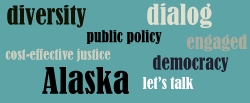Choosing our Future: Alaska’s Fiscal Options
Audience questions not answered during the event, with answers from Chair Cliff Groh.
- “If this is nonpartisan why is there no rebuttal?”
Alaska Common Ground works hard to get diverse perspectives represented on the stage at its events. There were diverse perspectives offered on October 5 from people on various sides about budget cuts, Permanent Fund Dividend cuts/Permanent Fund restructuring/POMV, and tax increases. Those on the stage included legislators from both major parties and a legislator who is an Independent.
- “With all due respect, tonightI see a bunch of white people talking to a bunch of white people – where is the rural Alaska and diversity of Anchorage?”
Regarding representation of rural Alaska on people who appeared on the stage, Rick Halford lives part-time in Aleknagik and Kathie Wasserman used to live in Pelican, where she served two terms as Mayor/City Administrator. Alaska Common Ground reached out to a number of Native Alaskans to appear on the stage October 5, but none were available.
- “Mark Twain said – ‘No Man’s life, liberty, or property are secure while the legislature is in session.'”
No comment.
- “Managing government, as in passing a budget without spending millions on special sessions nearly every non-election year?”
I think that this one goes to one or more legislators.
- Can you please specify which “structural reforms” you would make without using generalities?
I think Rep. Kopp used this phrase.
- How can we better diversify our economy so that we are not so dependent on fluctuating oil prices to support the state budget and Alaska’s economy in general?
This one could go to any one of the panelists, and Mouhcine Guettabi stands out as a good candidate.
- Why cannot Alaska model the Permanent Fund on the better performing Norwegian “Legacy Fund” which was founded when Norway developed oil? If/when other resources are developed such as “rare earth minerals,” should we develop a system like the “Legacy Fund” rather than the Permanent Fund to secure Alaska’s economic interest in our resources?
The Government Pension Fund Global is the official name of Norway’s sovereign wealth fund. Established in 1990 under the previous name of Government Petroleum Fund, that fund passed $1 trillion in assets in September of 2017, compared to the approximately $62 billion in assets of the Alaska Permanent Fund (of which approximately $40 billion is in the principal/corpus).
Although the question might be taken to imply that Norway’s sovereign wealth fund earns higher investment returns than the Alaska Permanent Fund, experts agree that the reason for the larger size of Norway’s fund does not lie in the superior investing skill of that fund’s managers.
Instead, the more important factors in the large size of Norway’s fund compared to the Permanent Fund involve (a) the larger take of Norway’s government from oil and gas development, which is tied to the greater risk that the Norwegian government bears and (b) the traditionally high taxes that the people of Norway pay compared to the people of Alaska.
Additionally, the earnings of the two funds have been used in different ways. The Permanent Fund Dividend has been paid out of the earnings of the Permanent Fund since the early 1980s, although the earnings have not been used in a substantial way to pay for the conventional elements of the State of Alaska’s budget. The government of Norway has fiscal rules that allow it to withdraw a portion of Norway’s sovereign wealth fund to put in the budget to—in the words of Norway’s central bank—”fuel the Norwegian economy.” According to the website of that central bank, “In its 2017 report on the long-term perspectives of the Norwegian economy, the government states that it intends the withdrawal from the fund over time should be equivalent to 3 percent of the fund’s value, down from the previous 4 percent.”
- What percentage of school funding is covered by state subsidies?
As of Fiscal Year 1997, it was 62 percent, according to Matthew D. Berman, “Public School Finance Programs of the United States and Canada: 1998-99,” found at https://nces.ed.gov/edfin/pdf/StFinance/Alaska.pdf on the Internet.
Alaska Common Ground is seeking more current information.
- What percentage of the total budget is used for roads and public safety?
Adding up the budget for the Department of Transportation and Public Facilities, the budget of the Department of Public Safety, and the capital budget produces a total of $425.7 million in Unrestricted General Fund (UGF) in Fiscal Year 2018. Given that the total UGF budget in FY18 is $4.328 billion, this would suggest that roads and public safety account for less than 10 percent of the budget.
- What are all currently existing taxes other than oil taxes (for example, there is a 3% state rental vehicle tax)?
The Alaska Department of Revenue’s Spring 2017 Revenue Sources Book shows the State of Alaska’s non-petroleum taxes going to the Unrestricted General Fund as:
- Alcoholic Beverage
- Tobacco Product—Cigarette
- Tobacco Product—Other
- Electric and Telephone Cooperative
- Marijuana
- Motor Fuel
- Motor Fuel (conservation surcharge)
- Tire Fee
- Corporate Income
- Fisheries Business
- Fishery Resource Landing
- Charitable Gaming
- Estate
- Large Passenger Vessel Gambling
- Mining
The State of Alaska also has non-petroleum taxes listed that not produce revenue that does not go into the Unrestricted General Fund, which is what most people in Alaska mean when they talk about “the budget.” Those taxes include:
- Commercial Passenger Vessel Excise
- Employment Security
- Vehicle Rental
- Can the public get a copy of each candidate’s donors and the amount contributed?
The Alaska Public Offices Commission (APOC) keeps some records.

